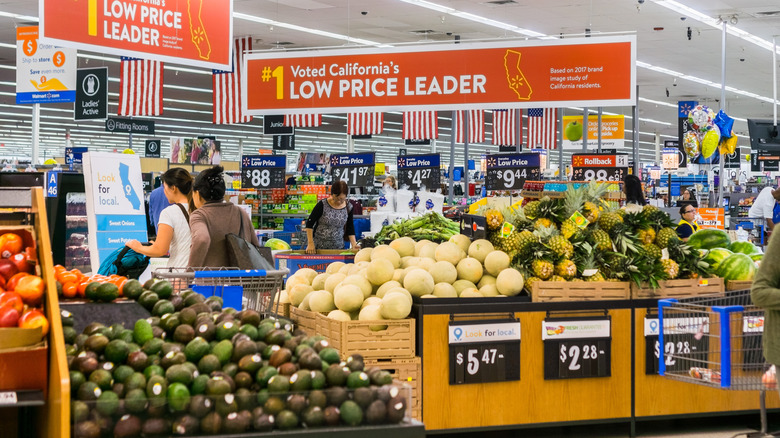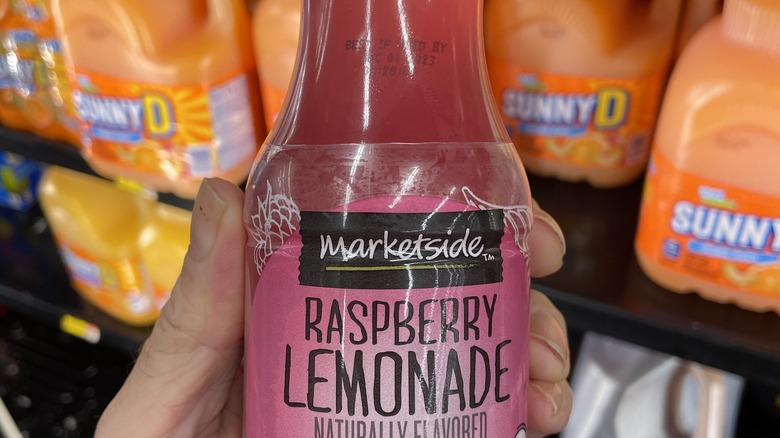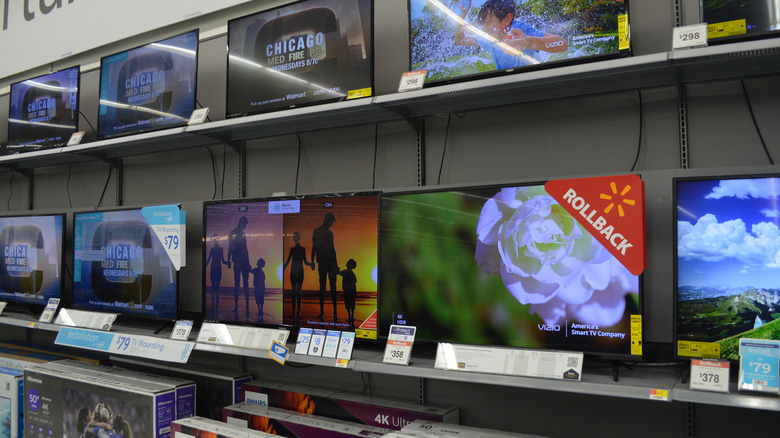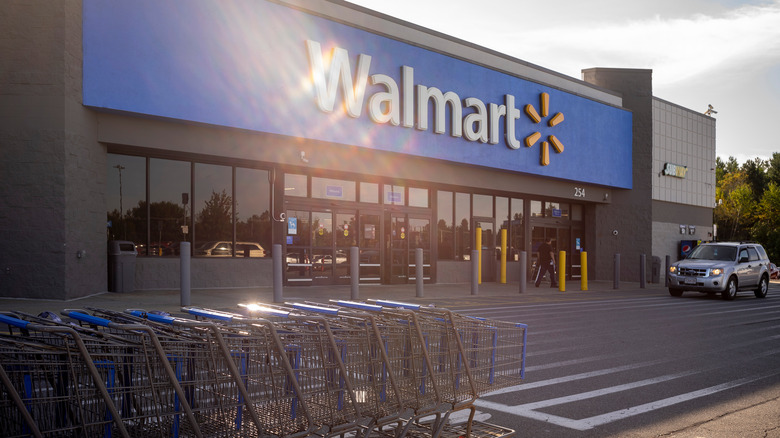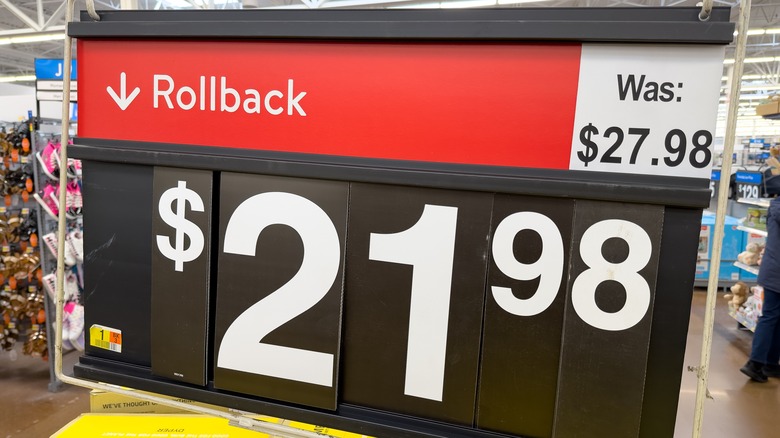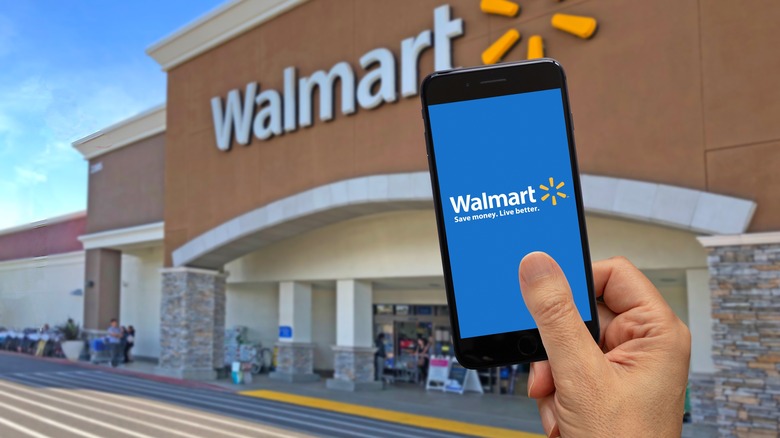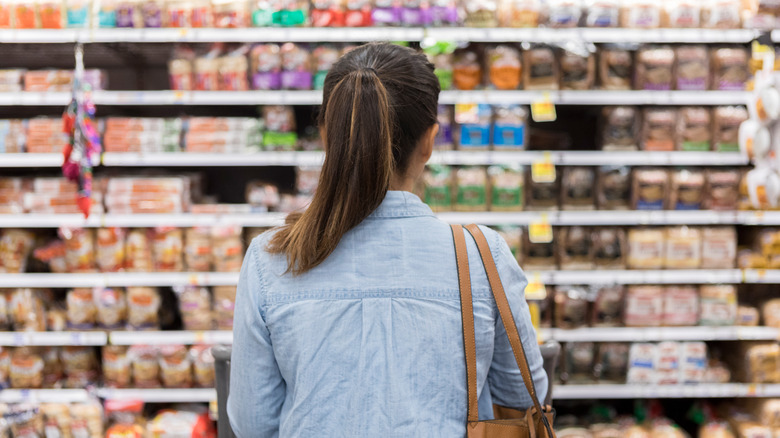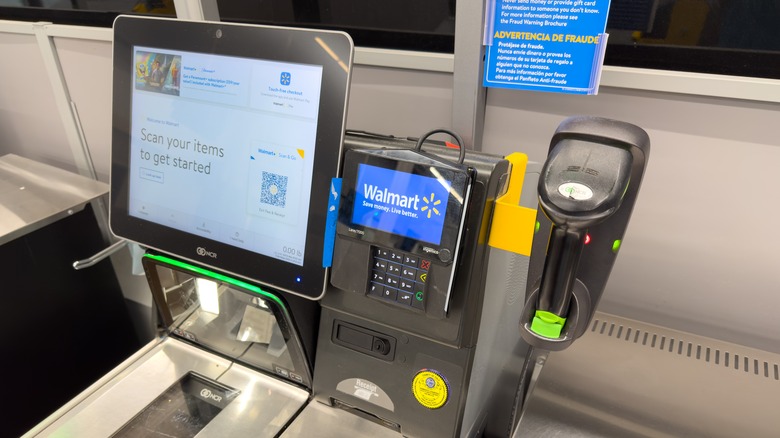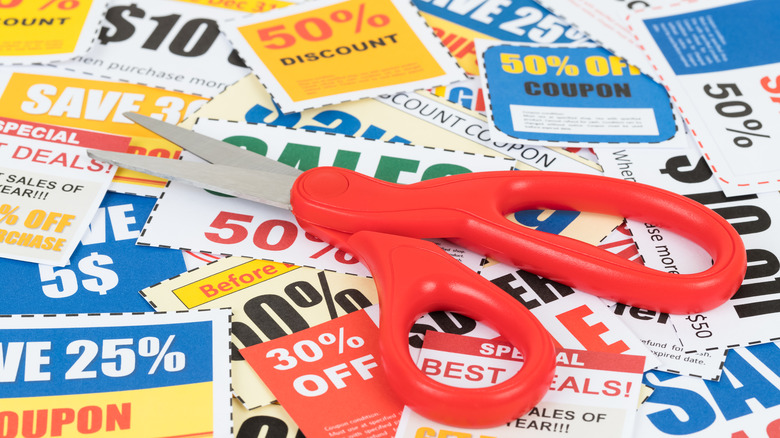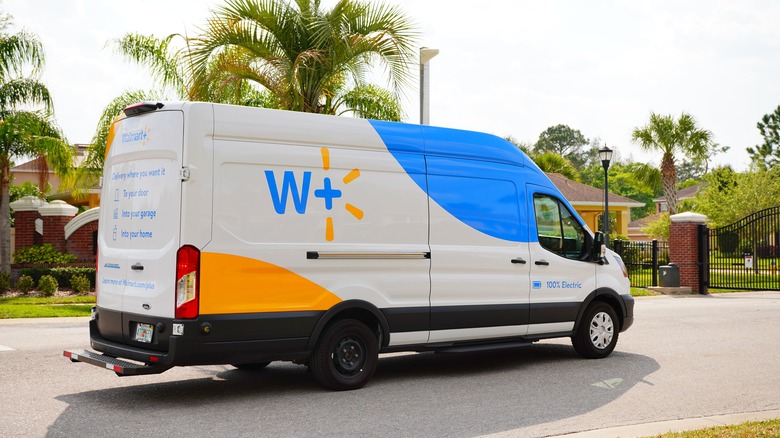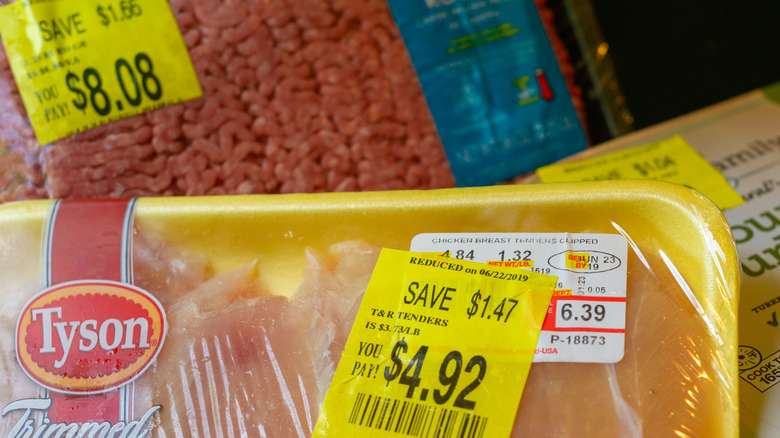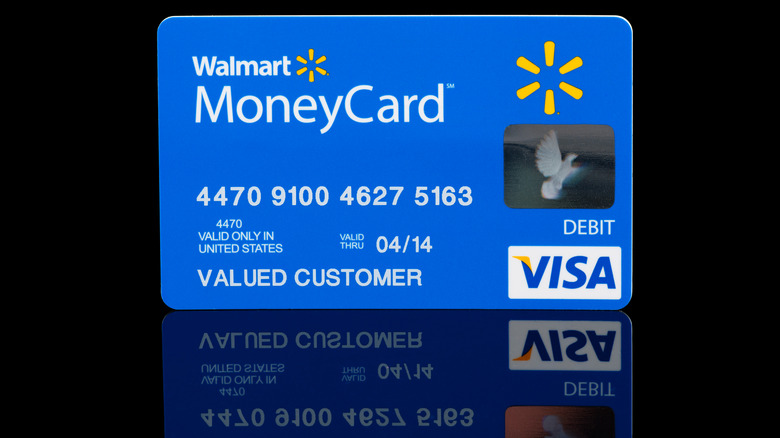The Biggest Mistakes To Avoid When Grocery Shopping At Walmart
As prices have risen over the past few years, more people have either started shopping at Walmart or started shopping at the store more frequently. The company is the No. 1 grocery retailer in the U.S., known for lower prices and convenient one-stop shopping at its supercenters. Walmart offers groceries at all three of its store types, from smaller offerings at regular stores to a complete grocery selection at its Neighborhood Markets and the aforementioned supercenters. Groceries account for 60% of the company's sales at the time of writing, and the company plans to add 300 new Bettergoods products before the end of 2024.
If you're one of those who are new (or relatively so) to Walmart, you could shop there as you would at any other grocery store. However, you'd be missing out on certain benefits and savings if you did that. Instead, take a look at the biggest mistakes to avoid when grocery shopping at Walmart so that you can get the best value for your money.
Not giving the store brands a try
Walmart has several store brands, including Great Value, Marketside, and Equate, and the quality is usually on par with that of nationwide brands. Depending on your tastes, the food from a Walmart brand may even seem a little better. The store brands are much cheaper than their brand-name counterparts and provide affordable options for people who can't spend that much on groceries. Unfortunately, many see store brands as lesser generic versions that aren't desirable.
If you're a shopper at Walmart, you're making a huge mistake by not trying the store brands. You don't have to like them, and you can switch back to brand names if you prefer. But give them a try, and then you may save money while still having tasty food. Some products, like Great Value cream cheese and Bettergoods cinnamon honey butter, have already garnered a following.
Walmart just added another store brand in May 2024. It's called Bettergoods and is geared toward shoppers who prefer more "chef-inspired" foods. Fast Company notes that the labels are reminiscent of Target's Good and Gather brand; Bettergoods appears to be a competitor for that customer base. The store has also expanded its organic produce offerings.
Not taking advantage of sensory-friendly hours
In mid-2023, Walmart experimented with sensory-friendly hours on Saturday mornings. Stores didn't play music, TVs didn't have moving images, and even lights were turned down a bit. The goal was to see if shoppers with sensory processing disorders, such as autism, found those hours easier to shop in. During regular hours, Walmarts can get pretty noisy and be absolutely overwhelming. The response to those couple of hours on Saturday? Positive beyond belief. Customers and even store associates were very happy with the quieter, calmer hours.
So Walmart decided to bring back the sensory-friendly hours and make them permanent in November 2023. But even better, they expanded those hours to be a daily event, rather than something that happened only once a week. All Walmarts in the United States and in Puerto Rico are included. If you want a quieter shopping environment, go to Walmart between 8 a.m. and 10 a.m., and if you don't think those hours make a difference, go to Walmart shortly before those hours end for the day. You'll see and hear what happens when the music, TVs, and bright lights start and understand just how different a shopping experience it can be. You may find that you prefer those quieter hours even if you don't live with sensory processing challenges.
Not shopping during off hours
If you've been shopping at Walmart during peak hours — think late Saturday mornings or in the early evening as everyone is going home from work — you know how ridiculous the crowds can be. Checkout lines stretch down aisles, and people weave carts around each other as they try to find what they need. If you can, try to shop during off hours to avoid crowds. Very early in the morning, such as when Walmart opens, or later at night on weekends are usually good times to have a little more space around you as you shop. You can also take advantage of early-morning delivery using the Walmart app.
If you have memories of shopping at a 24-hour Walmart at 1 a.m. or 2 a.m. and were hoping to once again take advantage of the overnight lack of crowds, we have unfortunate news for you. Despite the occasional rumor that pops up about Walmart bringing back their 24-hour stores, the company apparently has no plans to do so. Walmart ended many 24-hour services at stores in 2015 and 2019 and stopped 24-hour scheduling at the rest in 2020. The company has said it isn't planning to return to that type of schedule.
Not checking the rollbacks
Walmart has a pricing strategy known as rollbacks, where a current price is "rolled back" to a lower price. Rollbacks vary and can include just about anything on the shelves or on the website. They may last anywhere from a few days to a few months and are often pretty good deals. They're marked clearly on shelves, and you can even check out the current rollbacks on the website; for online listings, look for prices in green preceded by the word "now."
However, the rollbacks can be tricky. There have been cases where a rollback tag covered an original tag that had a lower price than the rollback. In some cases, that original tag was apparently very old and hadn't been removed; in other words, it was a much older price that wasn't really the pre-rollback price. Take a look at the tag and try to spot a date; if you can't see a date or find that the lower tag appears to be recent, speak with an employee or someone at the customer service desk to let them know.
Not having the website or app open on your phone as you shop
No matter how many times you shop at a certain location, you're going to encounter times when you just can't find a certain item. The food isn't sold out, but you can't find it because the entire section seems to be missing. You could wander the aisles looking or speak with employees who might be new and not know where anything is yet. Or you could pull out your smartphone and open the Walmart website or app.
Assuming you can get a signal in the store, you can use the website to find aisle numbers for almost every product. Keep in mind that stores can suddenly change the layout of the grocery section, and products may have sold out or been removed from the shelves before the website has had a chance to update. But checking the website is still preferable to searching aisles over and over again, as they at least give you a starting point. And if you have the Walmart app, you can pull up a map of the store that shows where each section is. This is very helpful when you're in a supercenter with enough sections to use up the alphabet (aisle numbers consist of a letter and number).
Assuming larger quantities are better deals
Walmart doesn't handle bulk purchasing in the same way as other stores. Other companies often have deals offering a discount if you buy a larger number of an item, such as a certain percent off the price if you buy a large case of soda instead of individual cans. At Walmart, the thinking is that the prices are already low, so buying more of a certain item doesn't really call for a discount. In fact, you may face limits on how much you can buy, such as when you're purchasing multiples of an item on the website. This is meant to stop resellers from purchasing lots of Walmart goods that they plan to sell at a profit.
Another issue with buying "more" at Walmart involves unit pricing. When you look at a price tag on the shelf, you can see the total price and a unit price that indicates how the total price breaks down. That lets you compare items that have different total prices to see which one is actually cheaper per unit. For example, a bag of chips might be a couple of dollars with a unit price of X cents per ounce, while a family-size bag of the same chips would have a larger total price but a smaller unit price. Yet at Walmart, anecdotal reports indicate that sometimes larger quantities have higher unit prices. The lesson here is to always check the unit price before tossing something in your cart.
Not checking if the self-checkout now has an item limit
Self-checkout has been a source of controversy, with some customers hating it and others loving it. Self-checkout can be speedy, and there's no worry about anyone secretly judging you for what you're buying. However, self-checkouts have also proved to be easy targets for retail theft, to the point where many chains are either limiting or removing self-checkout stations.
Walmart is no exception, but the severity of the limitations changes from store to store. In some cases, self-checkout is being limited to 15 items or less; in other cases, self-checkout is now reserved for Walmart+ members and certain delivery drivers. Yet other Walmarts, though, haven't imposed limits. These changes are still new as of May 2024, so you may find a supercenter with a 15-item limit just a few miles from a smaller location that still allows anyone to use the self-checkout no matter how many items they're buying.
Ignoring the price-matching policy
Walmart doesn't match prices from other companies, and it won't match prices from a physical Walmart store. Nor will it allow you to price-match items that you bought shortly before they went on sale or items you're buying as part of a special event like a holiday. But the company's price-match policy will allow a store to match a price from the Walmart website. Given that the website sometimes has sales that the stores don't, you may want to check out everything on your shopping list on the website first, and write down the prices. Ensure that the store location is set to the one you plan to visit, and know that once you're in the store, you can only use price-matching on one item per day.
Price-matching on Walmart.com — the stores and website have different policies — apparently used to be possible. However, Walmart's own policy page has a paragraph detailing how the website does not allow price-matching at all.
Forgetting your coupons
Did you know Walmart accepts manufacturer coupons? A lot of people don't realize it, but you can bring in those slips of paper and use them at either the self-checkout or the register. The coupons must be manufacturer coupons; you can't use coupons issued by another store, for example. Walmart won't double the coupons, and they also have to be paper; the store won't accept digital copies. Despite what seems like a long list of requirements, though, it's still worth it to bring in what you have and get at least a little bit of a discount on what you buy.
Walmart used to have a rather lax policy regarding coupons that customers loved. If you had a coupon that gave a bigger discount than what the item cost — say, something that went on sale at Walmart at the same time a coupon for it was circulating — you'd get the whole value of the coupon applied to your total purchase amount. This is a process called overage, and Walmart unfortunately stopped allowing overage in 2023. Another change to Walmart's coupon policy now limits the number of identical coupons you can have to four. So if you buy six cans of soup, for example, and you have six identical coupons for those cans, you'll be able to use only four of the coupons.
Not signing up for Walmart+
Walmart+ is a membership program that initially looks like a version of Amazon Prime, but the perks are a little different. Walmart+ gives you free shipping, but the program also gives you fuel discounts and special pharmacy benefits, as well as access to Paramount+, albeit the ad-supported version. People using certain government programs like WIC and SNAP can get Walmart+ at a discounted rate.
For those who shop at Walmart frequently and who love having things delivered — but who tend to order small amounts that usually wouldn't qualify for free shipping — Walmart+ can be a great way to save money. The program includes a scan-and-go feature in the Walmart app that lets you scan items as you pick them up instead of scanning them at the register. If you rarely shop at the store or on its website, though, you may end up spending more on the membership fees than you would save through the program.
Not checking the clearance shelves
As you wander around Walmart, you'll see items with yellow stickers in the produce and refrigerated sections. The stickers indicate those items' prices have been reduced for clearance because their best-by dates are approaching. But don't assume those are the only clearance goods. Each Walmart also has a section or an end cap reserved for shelf-stable foods that the store is clearing out, and there's usually a clearance rack near the bakery as well. (Note that it may not necessarily be right in the bakery section, but it should be near it.) Bakery clearance can be particularly nice because so many of those foods freeze well. The website also marks clearance goods with a yellow tag.
However, you should be aware of a few caveats. One is that "clearance" doesn't always equal "discounted." This sometimes happens with items that management no longer wants to sell. Another issue is that the time each day when items are moved or marked as clearance varies between stores. One location could have multiple markdown times each day while another marks things down only once. You could always ask the employees at a particular store when they set out clearance items in the bakery.
Not considering Walmart's prepaid debit and credit cards for groceries
Walmart offers both a prepaid debit card and a credit card that give you cash back when you use them for groceries and other types of purchases related to Walmart. For example, the Walmart credit card offered through Capital One gives you 5% cash back for qualifying purchases made on Walmart's website, which is a fantastic rate compared to other cards. You still get 2% cash back if you use the card in a Walmart store. The prepaid debit has lower limits but still offers 3% back for qualifying online purchases, and 1% for purchases made in stores and through grocery pickup and delivery, up to $75 per year.
Cash back is a welcome perk, but not everyone wants to use credit or prepaid debit cards for every purchase. Trying to remember which card gets you which rate for which purchases can be confusing and take up more of your time than you might like. Plus, you'll have to load cash onto Walmart's prepaid card, which might not be as convenient as just transferring some money into your checking account and using your bank debit. And if you use the credit card, you still have to pay the bill once it arrives. It's definitely a good idea to check out the card deals, but it's perfectly fine to stick with cash if you prefer.
